W.S. Darley & Co.: Difference between revisions
(Created page with "Sirens:<br> 3V8 (Darley<br><br> More info to come.") |
ArxCyberwolf (talk | contribs) |
||
| (8 intermediate revisions by 4 users not shown) | |||
| Line 1: | Line 1: | ||
{{Infobox manufacturer|hq=Itasca, IL|founder=William Stuart Darley|key_people=William Stuart Darley | |||
[[ | Paul Darley (CEO) | ||
Peter Darley(COO) | |||
Jeff Darley(COO)|products=Firefighting, emergency and defense equipment | |||
Outdoor warning sirens (formerly)|names=W.S. Darley & Co.|founded=1908|title=W.S. Darley & Co.|url=https://www.darley.com/|image=Darley.png}}'''W.S. Darley & Co.''' is a company founded by William S. Darley that has sold a wide variety of products since 1908, including fire apparatus equipment, traffic signals, robotics and defense equipment, as well as civil defense and fire sirens. While they no longer produce their own sirens, they currently sell rebranded [[Sentry Siren|Sentry]] products. | |||
== History == | |||
WIP | |||
==== Original Champions (1928-late 1930s) ==== | |||
Darley entered the siren business as early as 1928, when the demand for fire sirens was still quite high. Their first line of sirens was the Champions, a series of small omnidirectional sirens. These ranged from single and dual rotor horizontal sirens, as well as several vertical sirens. These came in many shapes and sizes. These were in production until the late 1930s. (see ''Products'' below) | |||
[[File:Darley Model 5TT.jpg|left|thumb|160x160px|A freshly restored Darley Model 5TT (C2 1/2), in private possession.]] | |||
==== Federal rebrands (1940s-1970s) ==== | |||
[[File:Darley Model 2.jpg|left|thumb|216x216px|A privately owned Darley Model 2 in 2004.]] | |||
In the 1940s, W.S. Darley & Co. discontinued their original Champion line of sirens, instead partnering with Federal Signal (then Federal Electric) to produce rebranded versions of Federal's [[Federal Electric Fedelcode|Fedelcode]] (and later [[Federal Signal Model 5|Model 5]]) line of sirens. These sirens, like all of Darley's sirens, are also known as "Champions" and are identical mechanically to their Federal counterparts, using the exact same rotors, stators, and motors. The only difference between a Federal branded siren and a Darley branded siren is the housing. Darley's housings are much more rounded and ornate than Federal's, often resembling a fire hydrant. The dual tone variants of the Model 5 and Model 7 are marked on the tag with two "T"s ('''5TT''' and '''7TT''') instead of Federal's 5T and 7T. Interestingly, Darley's rebranded Model 2 uses a 2½ hp motor instead of the standard 2 hp motor. | |||
[[File:Darley Type 10.jpg|thumb|160x160px|A Darley Type 10, located in Spindale, NC. Photo by TrainsandSirens1.]] | |||
Darley made their own variants of the Federal [[Federal Signal Model A|Model A]], [[Federal Signal Model L|Model L]], Type 1, [[Federal Signal Model 2|Type 2]], Type 5 (C2 1/2), Type 7 (C3 1/2) and their dual tone variants, and the [[Federal Signal STH-10|STH-10]]. Darley's variant of the STH-10 (called the Type 10) is particularly unique in that it has the core configured like its Model 5, with the core essentially flipped upside down with the motor below the rotor and the intake above it. Darley's STH-10 was also known as the "Darley 10 Horsepower" in advertisements. Darley would produce rebranded Federal sirens until sometime in the 1960s. However, Darley continues to sell the Federal Signal [[Federal Signal Q-Siren|Q-Siren]] to this day, as well as its electronic E-Q2B counterpart. | |||
==== ACA rebrands (1970s-1990s) ==== | |||
[[File:Darley Screamers.png|left|thumb|207x207px|A page from a 1970s Darley catalogue, advertising the Screamer rebrands.]] | |||
[[File:Darley Allertor.png|thumb|209x209px|Another 1970s era advertisement, which advertises rebranded Allertor 125, Screamer, SuperBanshee, and Hurricane 130MKII sirens.]] | |||
In the 1970s, W.S. Darley & Co. partnered with [[Alerting Communicators of America]] (ACA) to produce rebranded versions of their sirens. These sirens were physically identical to their ACA counterparts, with the only difference being the addition of "DARLEY" branding on the housings of the sirens. These were sold under the Champion brand and often advertised by their horsepower rating, and many different models were sold including the [[ACA Screamer|Screamer]], [[ACA Banshee|SuperBanshee]], [[ACA Allertor 125|Allertor 125]], and [[ACA Hurricane 130|Hurricane 130 MKII]]. | |||
In the 1980s, the Darley catalogue would be expanded, now also selling the standard [[ACA Banshee|Banshee 115]] (referred to as the Banshee 10), [[ACA Cyclone|Cyclone 120 and 125]], [[ACA Penetrator|Penetrator-15]] (advertised as the P-10), and Penetrator-50, as well as the [[ACA Alertronic|Alertronic]] line of electronic sirens (including the now-extinct Alertronic 5000). The sirens were now referred to by their ACA-given names, though they also kept their Darley-specific model names. The "DARLEY" branding on the housings was also removed by this point, making them indistinguishable from ACA-branded sirens. This partnership would continue through the 1980s, likely ending in the 1990s when ACA faced bankruptcy. It is unknown how many Darley-branded ACA sirens survive to this day, as the brandings on the sirens have likely faded, and later models lacked any branding. One W.S. Darley branded Allertor 125 is known to survive in service, located in Niles, MI. | |||
[[File:Darley Sentry Ad.png|left|thumb|220x220px|Darley's 1980s catalogue, advertising the 10V2T and F-2 alongside their ACA rebrands.]] | |||
[[File:Darley F-2 Ad.png|thumb|207x207px|Darley's rebranded Sentry F-2, F-5 and F-10.]] | |||
==== Sentry rebrands (1980s-present) ==== | |||
During the 1980s, Darley also chose to partner with [[Sentry Siren|Sentry Siren, Inc.]] selling rebranded versions of their sirens. These rebranded Sentry sirens were sold alongside Darley's rebranded ACA sirens, until ACA went out of business in 1992. Originally, only the Sentry [[Sentry 10V2T|10V2T]] and [[Sentry F-2|F-2]] were offered, under the names "Dual Tone General Alert Siren" and "110/220V Alarm Siren". The short-lived 10V2T-3S, F-5 and F-10 were also offered by Darley. | |||
After ACA's bankruptcy, Darley continued to partner with Sentry exclusively, becoming one of many companies reselling Sentry's sirens. These sirens are identical to their Sentry counterparts and are Sentry-branded from the factory. This makes it impossible to tell whether a given siren is from Sentry themselves, or from Darley. At least one siren is confirmed to have been bought from Darley, a [[Sentry 10V|10V]] located in Glenbeulah, WI. Darley expanded their options, and as of today now sells rebrands of the F-2, E-6, [[Sentry 3V8|3V8]] (and 3V8-H), [[Sentry 7V8|7V8]], [[Sentry 10V|10V]], [[Sentry 14V|14V]], 10V2T (despite it being discontinued by Sentry) and the [[Sentry 15V2T|15V2T]] (which Darley calls "the Decibel Busting 15HP Siren"). | |||
Darley is still partnered with Sentry today, and their sirens can be bought off of their eDarley website. | |||
== Products == | |||
=== Champion Little Giant === | |||
[[File:Darley Little Giant.png|thumb|160x160px|A lightly damaged and rusted Darley Little Giant, in private possession.]] | |||
The '''Champion Little Giant''' ('''Type 4A2¾''') is a horizontal dual-headed electric fire siren and was one of Darley's smaller horizontal offerings. Claimed to perform as well as sirens twice its size, it was a budget option that was essentially Darley's take on the Sterling Little Giant, and both offered relatively similar performance. This was primarily marketed to smaller and rural fire stations on a budget and those with no need for the coverage the larger offerings provided or industrial work lunch whistles. The Champion Little Giant makes use of a dual-sided 1½ hp 110 V AC 1 ph motor between each 10-port rotor and stator assembly, with 4 short and 4 long vanes on each rotor; no other port configurations were offered. The stators lack a ring on the edge of the stator ports, similarly to the [[Alerting Communicators of America|ACA]] [[ACA Screamer|Screamer]] sirens. The motor drove each rotor at around 4000 rpm. The Champion Little Giant only came in a 1½ hp configuration. | |||
Cylindrical projectors shield the rotor and stator from the elements, resembling the shape of the stators used in the larger Champion models. The fore and rear side of the projectors curve inwards and outwards respectively, and oil sumps are fixed above each of them. The siren is equipped with a mesh screen in front of the intakes, which keeps debris and rain out of the rotor. A trapezoidal elevated base with lugs on each corner is attached to the motor by 4 legs. This base allows the siren to be bolted to a flat surface. The bases' mold came standard with "CHAMPION W.S. DARLEY & CO, CHICAGO" lettering on each side. This base came standard with the siren but was removable and could be ordered without per request. Champion Little Giants are also frequently confused with Super Champions; Champion Little Giants are smaller, have projectors that cover the stator, and do not have elevated lettering; on Champion Little Giants, the area surrounding the lettering is raised, while on Super Champions it is not. The Champion Little Giant was largely overshadowed by its original Sterling counterpart, and very few of them are still extant. | |||
=== Single Head Champion === | |||
The '''Single Head Champion''' is a lineup of 4 horizontal dual-headed fire sirens, all of which only utilize one rotor and stator assembly. These all utilize a single-sided 110 or 220 V AC motor of varying horsepower of phase behind an 8-port rotor and stator assembly, with 4 short and 4 long vanes on each rotor; no other port configurations were offered. The fore and rear side of the stator curve inwards and outwards respectively, and oil sumps are fixed above it. The siren is equipped with a mesh screen in front of the intake and around the stator ports, which keeps debris and rain out of the rotor. A trapezoidal elevated base with lugs on each corner is attached to the motor by 4 legs. This base allows the siren to be bolted to a flat surface. The bases' mold came standard with "CHAMPION W.S. DARLEY & CO, CHICAGO" lettering on each side. This base came standard with the siren but was removable and could be ordered without per request. Single Head Champions, with the exception of the single-sided motor and lack of another rotor and stator, are identical to the Super Champion. Single Head Champions were not exactly the most popular sirens and are today very scarce due to their lackluster output and introduction of the Champion Little Giant, which was dual-headed and cheaper than any of the Single Head Champions. | |||
Specifications for individual Single Head Champions are listed in the table below. | |||
{| class="wikitable mw-collapsible" | |||
|+Single Head Champions | |||
!No. | |||
!Horsepower | |||
!Voltage | |||
!Phase | |||
|- | |||
|93 | |||
|2½ | |||
|220 | |||
|3 | |||
|- | |||
|95 | |||
|3½ | |||
|220 | |||
|3 | |||
|- | |||
|98 | |||
|5 | |||
|220 | |||
|3 | |||
|- | |||
|99 | |||
|5 | |||
|110/220 | |||
|1 | |||
|} | |||
=== Peerless Champion === | |||
[[File:Darley Peerless Champion.png|thumb|160x160px|A Darley Peerless Champion, as advertised.]] | |||
The '''Peerless Champion''' is a horizontal dual-headed electric fire siren and was one of Darley's smaller horizontal offerings. It was a competitor of the wildly popular [[Sterling Siren Fire Alarm Co.|Sterling]] [[Sterling Model M|Model M]], although the Champion's inferior performance made it an unfavorable choice. This was primarily marketed to smaller and rural fire stations on a budget and those with no need for the coverage the larger offerings provided. The Peerless Champion makes use of a dual-sided 5 hp 220 V AC 3 ph motor between each 8-port rotor and stator assembly, with 4 short and 4 long vanes on each rotor; no other port configurations were offered. The Peerless Champion only came in a 5 hp configuration. The fore and rear side of the stators curve inwards and outwards respectively, and oil sumps are fixed above each of them. The siren is equipped with a mesh screen in front of the intakes and around the stator ports, which keeps debris and rain out of the rotor. A trapezoidal elevated base with lugs on each corner is attached to the motor by 4 legs. This base allows the siren to be bolted to a flat surface. | |||
The bases' mold came standard with "CHAMPION W.S. DARLEY & CO, CHICAGO" lettering on each side. This base came standard with the siren but was removable and could be ordered without per request. Peerless Champions can be differentiated from the larger Super Champion by the size, length of the stators and elevation of the lettering on the siren's base; on Peerless Champions, the area surrounding the lettering is raised, while on Super Champions it is not. There are no other visible differences between these sirens besides this. An omnidirectional siren named the Champion Giant used the rotor and stator introduced by the Peerless Champion. This was essentially a single-headed Peerless Champion with additional attachments. The Champion Giant was interestingly far more popular than the Peerless Champion and was one of the most successful of Darley's sirens. Unlike its vertical relative, the Peerless Champion saw limited success compared to the Super Champion and was eliminated from Darley's lineup after a very brief production lifespan. Only 2 examples of Peerless Champions are still extant today, far overshadowed by the larger Super Champion and Champion Giant. | |||
=== Super Champion === | |||
[[File:Darley Super Champion.jpg|left|thumb|160x160px|A Darley Super Champion, which is located in Erwin, TN. This picture was taken during renovations, and the siren was temporarily taken down.]] | |||
The '''Super Champion''' is a horizontal dual-headed electric fire siren. It was the larger relative of the Peerless Champion and was far more successful, providing superior performance and a formidable competition to the Model M. This was intended for urban fire stations with the expenses to spend on a more powerful siren. The Super Champion uses elongated Peerless Champion rotor and stators for greater sound output and is driven by a dual-sided 7½ hp 220 V AC 3 ph motor. 8 or 16-port rotor and stator assemblies were offered, with 4 short and 4 long vanes on each rotor. Only 1 port configuration is used on each siren and no dual-tone configurations were ever offered. The 16-port Super Champions, very few of which were ever installed, in reality only used 16-port stators; the rotors remained 8-port, leading to significant undertones during operation. These sirens only came in a 7½ hp configuration. The fore and rear side of the stators curve inwards and outwards respectively, and oil sumps are fixed above each of them. | |||
The siren is equipped with a mesh screen in front of the intakes around the stator ports, which keeps debris and rain out of the rotor. As these were prone to damage, detaching, or simply degrading with age, many Super Champions can be seen with modifications or large protective housings to further protect the siren. A trapezoidal elevated base with lugs on each corner is attached to the motor by 4 legs. This base allows the siren to be bolted to a flat surface. The bases' mold came standard with "CHAMPION W.S. DARLEY & CO, CHICAGO" lettering on each side. This base came standard with the siren but was removable and could be ordered without per request. Super Champions can be differentiated from the smaller Peerless Champion by the size, length of the stators and elevation of the lettering on the siren's base; on Peerless Champions, the area surrounding the lettering is raised, while on Super Champions it is not. | |||
There are no other visible differences between these sirens besides this. Champion Little Giants, smaller vertical sirens, are also frequently confused with Super Champions; Super Champions are larger, do not have projectors that cover the stator, and do not have elevated lettering, while Champion Little Giants do. The Champion Giant's larger counterpart(s), the Champion Fire Siren(s), used the rotor and stator introduced by the Super Champion. Like the Peerless Champion, the Champion Fire Siren(s) was/were essentially (a) single-headed Peerless Champion(s) with additional attachments. Ironically, the Champion Giant overshadowed the Champion Fire Siren, whereas the opposite was true for the Peerless and Super Champion. The Super Champion was a success for Darley and remained one of their most popular offerings until it was eliminated from their lineup in 1948 following the partnership with Federal. Super Champions, while not exactly widespread, are still relatively common and are most commonly used as fire sirens or noon whistles. | |||
=== Master Champion === | |||
[[File:Champions of the world.png|thumb|160x160px|The Master and Royal Champions are mentioned in this section of a 1932 Darley ad, entitled "Champions of the World".]] | |||
The '''Master Champion''' was a very scarcely advertised fire siren with very little knowledge surrounding it. Absolutely nothing is known about the Master Champion, apart from the fact that it is most likely less powerful than the Royal Champion and was advertised as a "sturdy" siren. The way the "Champions of the World" segment (from which the Master and Royal Champion originate) is structured likely suggests that this was a "budget" offering. If it was produced to begin with the Master Champion was likely a failure, and no units are known to exist. | |||
=== Royal Champion === | |||
The '''Royal Champion''' is a horizontal dual-headed electric fire siren and was Darley's attempt at creating a louder Super Champion without requiring larger rotors. Little is known about the Royal Champion, as it, alongside the Master Champion, was only mentioned once in a 1932 advertisement, though it is known that it was a 12 hp siren. It is likely that Darley took heavy inspiration by the [[Sterling Siren Fire Alarm Co.|Sterling]] [[Sterling Model M|Super Quad]], and likely used a similar 4-rotor setup to justify the increase in horsepower. Its exact appearance is unknown, and there are no known surviving units today. Seeing as these were only ever mentioned in a singular advert, if they were produced to begin with the Royal Champion was likely a failure, a fate similarly met by the Super Quad. No units are known to exist. | |||
=== Champion Giant === | |||
[[File:Darley Champion Giant.jpg|left|thumb|160x160px|A Darley Champion Giant, located in Jackson, GA. Image by Brendan Williamson.]] | |||
The '''Champion Giant''' ('''Type 2A2¾''') is a vertical single-headed electric fire siren, and the smallest of the 3-legged vertical Champions. It borrows a singular 13½" rotor and stator from the Peerless Champion and is driven by a single-sided 2½ hp 220 V AC motor below the rotor and stator assembly. 1 ph, 3 ph, and universal motor configurations were offered. The intake on the Champion Giant is protected by a large 2-piece intake cover attached to the stator, which keeps debris and rain out of the rotor. The siren is equipped with a mesh screen around the intake and stator ports; as these were prone to damage, detaching, or simply degrading with age, many Champion Giants can be seen with modifications to further protect the siren's intake and stator. 3 curved mounting legs below the motor suspend the siren and have lugs at the bases which allow the siren to be bolted to a flat surface. | |||
Champion Giants are easily distinguishable from the larger 2 3-legged vertical Champions by the notably shorter stator and legs that have a longer, less prominently curved form. Champion Giants are exclusively 8-port single tone, and have intake covers that extend halfway down the stator. The model name of the siren and many other Darley offerings is based off a factory code; what exactly the names correlate to is unknown, sans the "U", "S" and "T" suffixes which denote the type of motor used and correspond to universal, 1 ph, and 3 ph respectively. These were some of the cheapest sirens available in the 1930s (advertised as "The Buy of 1932" in a 1932 advertisement), which made them quite popular at the time despite the larger Champion Fire Siren(s) offering superior performance. Champion Giants, while not exactly widespread, are still relatively common and have even found their way as far north as Quebec, Canada. | |||
=== Champion Fire Siren === | |||
[[File:Vertical Champion Giant.jpg|thumb|160x160px|A 5 hp 12-port Darley Champion Fire Siren, located in Garrison, NB. Photo by Railroad Sign Productions.]] | |||
The '''Champion Fire Siren''' name does not refer to a singular model, but rather 2 vertical single-headed electric fire sirens which went under the same name and are visually identical. These were larger than the Champion Giant and were pushed far more than the Giant in Darley advertisements, although their hefty price tag ironically made the Champion Fire Siren(s) less of a popular choice. The Fire Siren(s) borrow(s) a singular 13½" rotor and stator from the Super Champion and is/are driven by a single-sided 220 V AC motor below the rotor and stator assembly. 1 ph, 3 ph, and universal motor configurations were offered. The difference between the 2 Fire Siren models is the horsepower; 5 hp ('''Type 2C2½''') and 7½ hp ('''Type 2C3½''') were offered; there are no other differences between the Champion Fire Sirens besides this. Differentiating them is impossible without a view of the manufacturing tag on the motor. | |||
The intake on the Champion Fire Siren(s) is/are protected by an either single or 2-peice intake cover attached to the stator, which keeps debris and rain out of the rotor. The cover is topped with a small eagle decoration, although this decoration has never been seen on any existing Champion Fire Siren installations and was either rarely included or never produced at all. The siren(s) is/are equipped with a mesh screen around the intake and stator ports; as these were prone to damage, detaching, or simply degrading with age, many Champion Fire Sirens can be seen with modifications to further protect the siren's intake and stator. 3 curved mounting legs below the motor suspend the siren(s) and have lugs at the bases which allow the siren(s) to be bolted to a flat surface. Champion Fire Sirens are distinguishable from the smaller Champion Giant by the taller stator and shorter legs that have a longer, less prominently curved form. | |||
These sirens could come in both 8 or 12-port single tone, and have intake covers that extend to the very top of the stator. As the Super Champion, of which the Champion Fire Siren(s) is/are derived from, were offered in a 16-port single tone configuration, it is possible that 16-port Champion Fire Sirens could have been requested, although none of these, if they existed to begin with, have surfaced. The model name of the siren and many other Darley offerings is based off a factory code; what exactly the names correlate to is unknown, sans the "U", "S" and "T" suffixes which denote the type of motor used and correspond to universal, 1 ph, and 3 ph respectively. Champion Fire Sirens themselves were not as popular as their smaller counterpart, and as a result Champion Fire Sirens are harder to come by. Even less of which are operational to begin with; most Champion Fire Sirens that are see service either as fire sirens or noon whistles. | |||
=== Weatherproof Champion === | |||
[[File:Darley WPC Rotor.png|thumb|169x169px|A Weatherproof Champion with an exposed Darley core, located in Cordele, GA. Photo credit to murrfarms.]] | |||
[[File:Darley Weatherproof Champion .png|left|thumb|160x160px|A 12-port 5 hp Weatherproof Champion with a Darley core, located in Fort Reno, OK. Photo credit to Valra Bellkeys.]] | |||
[[File:FedelDarley.jpg|thumb|160x160px|A Darley Weatherproof Champion with a Fedelcode core. Note the two-piece rainshield and single row of directional louvres compared to the image above.]] | |||
The '''Weatherproof Champions''' are vertical single-headed electric fire sirens, and were designed with durability and longevity in mind, rather than price and raw performance. Unlike the vertical 3-legged Champions, the Weatherproof Champions use a motor-over-rotor configuration, with the motor on top and the rotor and stator below it. A cylindrical base. Under the stator a circular base with lugs allows the siren to be bolted to a flat surface. These sirens are placed inside weatherproof housings with a rounded top, and many slits are placed across the diameter of the housing to allow sound to escape, similar to a [[Sparton Corp.|Sparton]] [[Sparton Corp.|Model 37]]/[[Sparton Corp.|38]]. While this does a much better job of protecting the siren itself from the elements, it does harm the siren's ability to project, and they tend to be quieter than other Champion models. | |||
The Weatherproof Champion was offered in 3 different varieties; the smallest of the 3, a 2½ hp variant, is similar to the Federal Signal Model 2, and comes exclusively in 6-port single tone. It uses a universal motor, with shorter overall shorter housings than the other Weatherproof Champions. The mid-range 5 hp variant, which uses a standard 5 hp AC motor, comes with an either 8-port or 12-port rotor with 6 long vanes and 6 short vanes, giving it a significant rasp, similar to Sterling's [[Sterling Vertical Siren|5VX]] sirens, of which these sirens were competitors of. 5 hp models are taller than the 2½ hp model and have 2 rows of slits. Finally, the 7½ hp variant, which is similar to the 5 hp model, comes exclusively in 12-port single tone, with a rotor that has all long vanes and no short vanes. | |||
Weatherproof Champions produced from the 1940s onwards were simply [[Federal Electric Fedelcode|Fedelcode]] sirens with Darley's weatherproof housings, instead of Darley's own designs. These can be told apart from earlier Darley-designed models by the style of the louvres, as the louvres are bi-directional on Darley models, while the louvres are open on only 1 side on Federal rebranded Champions. Federal rebranded Champions also only have 1 row of ports, and a 2-piece cover. Darley models only have a single-piece cover, and 2 rows of slits. Sirens that received weatherproof housings included the [[Federal Signal Model 5|C2 1/2]], [[Federal Electric Fedelcode|Model 1]], and Model 2. These would be the standard Weatherproof Champion design until their discontinuation. The Weatherproof Champions were one of the most popular of Darley's sirens despite other models offering superior performance. Even today these sirens are very recognizable and are synonymous with the Darley name. Weatherproof Champions can be found across the United States largely serving as either fire sirens, weather sirens, or noon whistles. | |||
[[Category:Company pages]] | |||
[[Category:Sentry Siren Incorporated]] | |||
[[Category:Alerting Communicators of America]] | |||
[[Category:Federal Signal Corporation]] | |||
[[Category:Omnidirectional Sirens]] | |||
[[Category:Directional Sirens]] | |||
[[Category:Industrial Small Sirens]] | |||
[[Category:Electromechanical Sirens]] | |||
__INDEX__ | |||
Latest revision as of 23:13, 15 November 2024
| W.S. Darley & Co. | |
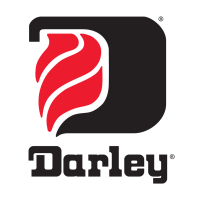
| |
| Names | W.S. Darley & Co. |
|---|---|
| Headquarters | Itasca, IL |
| Founder | William Stuart Darley |
| Key people | William Stuart Darley
Paul Darley (CEO) Peter Darley(COO) Jeff Darley(COO) |
| Founded | 1908 |
| Products | Firefighting, emergency and defense equipment
Outdoor warning sirens (formerly) |
| Website | https://www.darley.com/ |
W.S. Darley & Co. is a company founded by William S. Darley that has sold a wide variety of products since 1908, including fire apparatus equipment, traffic signals, robotics and defense equipment, as well as civil defense and fire sirens. While they no longer produce their own sirens, they currently sell rebranded Sentry products.
History
WIP
Original Champions (1928-late 1930s)
Darley entered the siren business as early as 1928, when the demand for fire sirens was still quite high. Their first line of sirens was the Champions, a series of small omnidirectional sirens. These ranged from single and dual rotor horizontal sirens, as well as several vertical sirens. These came in many shapes and sizes. These were in production until the late 1930s. (see Products below)
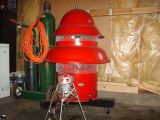
Federal rebrands (1940s-1970s)
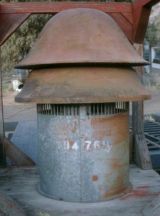
In the 1940s, W.S. Darley & Co. discontinued their original Champion line of sirens, instead partnering with Federal Signal (then Federal Electric) to produce rebranded versions of Federal's Fedelcode (and later Model 5) line of sirens. These sirens, like all of Darley's sirens, are also known as "Champions" and are identical mechanically to their Federal counterparts, using the exact same rotors, stators, and motors. The only difference between a Federal branded siren and a Darley branded siren is the housing. Darley's housings are much more rounded and ornate than Federal's, often resembling a fire hydrant. The dual tone variants of the Model 5 and Model 7 are marked on the tag with two "T"s (5TT and 7TT) instead of Federal's 5T and 7T. Interestingly, Darley's rebranded Model 2 uses a 2½ hp motor instead of the standard 2 hp motor.

Darley made their own variants of the Federal Model A, Model L, Type 1, Type 2, Type 5 (C2 1/2), Type 7 (C3 1/2) and their dual tone variants, and the STH-10. Darley's variant of the STH-10 (called the Type 10) is particularly unique in that it has the core configured like its Model 5, with the core essentially flipped upside down with the motor below the rotor and the intake above it. Darley's STH-10 was also known as the "Darley 10 Horsepower" in advertisements. Darley would produce rebranded Federal sirens until sometime in the 1960s. However, Darley continues to sell the Federal Signal Q-Siren to this day, as well as its electronic E-Q2B counterpart.
ACA rebrands (1970s-1990s)
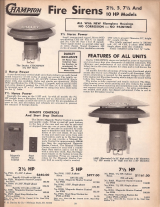
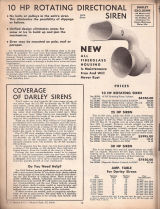
In the 1970s, W.S. Darley & Co. partnered with Alerting Communicators of America (ACA) to produce rebranded versions of their sirens. These sirens were physically identical to their ACA counterparts, with the only difference being the addition of "DARLEY" branding on the housings of the sirens. These were sold under the Champion brand and often advertised by their horsepower rating, and many different models were sold including the Screamer, SuperBanshee, Allertor 125, and Hurricane 130 MKII.
In the 1980s, the Darley catalogue would be expanded, now also selling the standard Banshee 115 (referred to as the Banshee 10), Cyclone 120 and 125, Penetrator-15 (advertised as the P-10), and Penetrator-50, as well as the Alertronic line of electronic sirens (including the now-extinct Alertronic 5000). The sirens were now referred to by their ACA-given names, though they also kept their Darley-specific model names. The "DARLEY" branding on the housings was also removed by this point, making them indistinguishable from ACA-branded sirens. This partnership would continue through the 1980s, likely ending in the 1990s when ACA faced bankruptcy. It is unknown how many Darley-branded ACA sirens survive to this day, as the brandings on the sirens have likely faded, and later models lacked any branding. One W.S. Darley branded Allertor 125 is known to survive in service, located in Niles, MI.
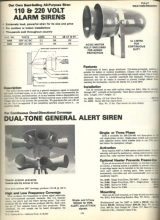
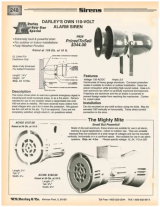
Sentry rebrands (1980s-present)
During the 1980s, Darley also chose to partner with Sentry Siren, Inc. selling rebranded versions of their sirens. These rebranded Sentry sirens were sold alongside Darley's rebranded ACA sirens, until ACA went out of business in 1992. Originally, only the Sentry 10V2T and F-2 were offered, under the names "Dual Tone General Alert Siren" and "110/220V Alarm Siren". The short-lived 10V2T-3S, F-5 and F-10 were also offered by Darley.
After ACA's bankruptcy, Darley continued to partner with Sentry exclusively, becoming one of many companies reselling Sentry's sirens. These sirens are identical to their Sentry counterparts and are Sentry-branded from the factory. This makes it impossible to tell whether a given siren is from Sentry themselves, or from Darley. At least one siren is confirmed to have been bought from Darley, a 10V located in Glenbeulah, WI. Darley expanded their options, and as of today now sells rebrands of the F-2, E-6, 3V8 (and 3V8-H), 7V8, 10V, 14V, 10V2T (despite it being discontinued by Sentry) and the 15V2T (which Darley calls "the Decibel Busting 15HP Siren").
Darley is still partnered with Sentry today, and their sirens can be bought off of their eDarley website.
Products
Champion Little Giant
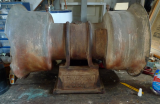
The Champion Little Giant (Type 4A2¾) is a horizontal dual-headed electric fire siren and was one of Darley's smaller horizontal offerings. Claimed to perform as well as sirens twice its size, it was a budget option that was essentially Darley's take on the Sterling Little Giant, and both offered relatively similar performance. This was primarily marketed to smaller and rural fire stations on a budget and those with no need for the coverage the larger offerings provided or industrial work lunch whistles. The Champion Little Giant makes use of a dual-sided 1½ hp 110 V AC 1 ph motor between each 10-port rotor and stator assembly, with 4 short and 4 long vanes on each rotor; no other port configurations were offered. The stators lack a ring on the edge of the stator ports, similarly to the ACA Screamer sirens. The motor drove each rotor at around 4000 rpm. The Champion Little Giant only came in a 1½ hp configuration.
Cylindrical projectors shield the rotor and stator from the elements, resembling the shape of the stators used in the larger Champion models. The fore and rear side of the projectors curve inwards and outwards respectively, and oil sumps are fixed above each of them. The siren is equipped with a mesh screen in front of the intakes, which keeps debris and rain out of the rotor. A trapezoidal elevated base with lugs on each corner is attached to the motor by 4 legs. This base allows the siren to be bolted to a flat surface. The bases' mold came standard with "CHAMPION W.S. DARLEY & CO, CHICAGO" lettering on each side. This base came standard with the siren but was removable and could be ordered without per request. Champion Little Giants are also frequently confused with Super Champions; Champion Little Giants are smaller, have projectors that cover the stator, and do not have elevated lettering; on Champion Little Giants, the area surrounding the lettering is raised, while on Super Champions it is not. The Champion Little Giant was largely overshadowed by its original Sterling counterpart, and very few of them are still extant.
Single Head Champion
The Single Head Champion is a lineup of 4 horizontal dual-headed fire sirens, all of which only utilize one rotor and stator assembly. These all utilize a single-sided 110 or 220 V AC motor of varying horsepower of phase behind an 8-port rotor and stator assembly, with 4 short and 4 long vanes on each rotor; no other port configurations were offered. The fore and rear side of the stator curve inwards and outwards respectively, and oil sumps are fixed above it. The siren is equipped with a mesh screen in front of the intake and around the stator ports, which keeps debris and rain out of the rotor. A trapezoidal elevated base with lugs on each corner is attached to the motor by 4 legs. This base allows the siren to be bolted to a flat surface. The bases' mold came standard with "CHAMPION W.S. DARLEY & CO, CHICAGO" lettering on each side. This base came standard with the siren but was removable and could be ordered without per request. Single Head Champions, with the exception of the single-sided motor and lack of another rotor and stator, are identical to the Super Champion. Single Head Champions were not exactly the most popular sirens and are today very scarce due to their lackluster output and introduction of the Champion Little Giant, which was dual-headed and cheaper than any of the Single Head Champions.
Specifications for individual Single Head Champions are listed in the table below.
| No. | Horsepower | Voltage | Phase |
|---|---|---|---|
| 93 | 2½ | 220 | 3 |
| 95 | 3½ | 220 | 3 |
| 98 | 5 | 220 | 3 |
| 99 | 5 | 110/220 | 1 |
Peerless Champion
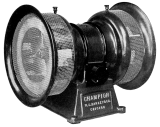
The Peerless Champion is a horizontal dual-headed electric fire siren and was one of Darley's smaller horizontal offerings. It was a competitor of the wildly popular Sterling Model M, although the Champion's inferior performance made it an unfavorable choice. This was primarily marketed to smaller and rural fire stations on a budget and those with no need for the coverage the larger offerings provided. The Peerless Champion makes use of a dual-sided 5 hp 220 V AC 3 ph motor between each 8-port rotor and stator assembly, with 4 short and 4 long vanes on each rotor; no other port configurations were offered. The Peerless Champion only came in a 5 hp configuration. The fore and rear side of the stators curve inwards and outwards respectively, and oil sumps are fixed above each of them. The siren is equipped with a mesh screen in front of the intakes and around the stator ports, which keeps debris and rain out of the rotor. A trapezoidal elevated base with lugs on each corner is attached to the motor by 4 legs. This base allows the siren to be bolted to a flat surface.
The bases' mold came standard with "CHAMPION W.S. DARLEY & CO, CHICAGO" lettering on each side. This base came standard with the siren but was removable and could be ordered without per request. Peerless Champions can be differentiated from the larger Super Champion by the size, length of the stators and elevation of the lettering on the siren's base; on Peerless Champions, the area surrounding the lettering is raised, while on Super Champions it is not. There are no other visible differences between these sirens besides this. An omnidirectional siren named the Champion Giant used the rotor and stator introduced by the Peerless Champion. This was essentially a single-headed Peerless Champion with additional attachments. The Champion Giant was interestingly far more popular than the Peerless Champion and was one of the most successful of Darley's sirens. Unlike its vertical relative, the Peerless Champion saw limited success compared to the Super Champion and was eliminated from Darley's lineup after a very brief production lifespan. Only 2 examples of Peerless Champions are still extant today, far overshadowed by the larger Super Champion and Champion Giant.
Super Champion
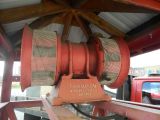
The Super Champion is a horizontal dual-headed electric fire siren. It was the larger relative of the Peerless Champion and was far more successful, providing superior performance and a formidable competition to the Model M. This was intended for urban fire stations with the expenses to spend on a more powerful siren. The Super Champion uses elongated Peerless Champion rotor and stators for greater sound output and is driven by a dual-sided 7½ hp 220 V AC 3 ph motor. 8 or 16-port rotor and stator assemblies were offered, with 4 short and 4 long vanes on each rotor. Only 1 port configuration is used on each siren and no dual-tone configurations were ever offered. The 16-port Super Champions, very few of which were ever installed, in reality only used 16-port stators; the rotors remained 8-port, leading to significant undertones during operation. These sirens only came in a 7½ hp configuration. The fore and rear side of the stators curve inwards and outwards respectively, and oil sumps are fixed above each of them.
The siren is equipped with a mesh screen in front of the intakes around the stator ports, which keeps debris and rain out of the rotor. As these were prone to damage, detaching, or simply degrading with age, many Super Champions can be seen with modifications or large protective housings to further protect the siren. A trapezoidal elevated base with lugs on each corner is attached to the motor by 4 legs. This base allows the siren to be bolted to a flat surface. The bases' mold came standard with "CHAMPION W.S. DARLEY & CO, CHICAGO" lettering on each side. This base came standard with the siren but was removable and could be ordered without per request. Super Champions can be differentiated from the smaller Peerless Champion by the size, length of the stators and elevation of the lettering on the siren's base; on Peerless Champions, the area surrounding the lettering is raised, while on Super Champions it is not.
There are no other visible differences between these sirens besides this. Champion Little Giants, smaller vertical sirens, are also frequently confused with Super Champions; Super Champions are larger, do not have projectors that cover the stator, and do not have elevated lettering, while Champion Little Giants do. The Champion Giant's larger counterpart(s), the Champion Fire Siren(s), used the rotor and stator introduced by the Super Champion. Like the Peerless Champion, the Champion Fire Siren(s) was/were essentially (a) single-headed Peerless Champion(s) with additional attachments. Ironically, the Champion Giant overshadowed the Champion Fire Siren, whereas the opposite was true for the Peerless and Super Champion. The Super Champion was a success for Darley and remained one of their most popular offerings until it was eliminated from their lineup in 1948 following the partnership with Federal. Super Champions, while not exactly widespread, are still relatively common and are most commonly used as fire sirens or noon whistles.
Master Champion

The Master Champion was a very scarcely advertised fire siren with very little knowledge surrounding it. Absolutely nothing is known about the Master Champion, apart from the fact that it is most likely less powerful than the Royal Champion and was advertised as a "sturdy" siren. The way the "Champions of the World" segment (from which the Master and Royal Champion originate) is structured likely suggests that this was a "budget" offering. If it was produced to begin with the Master Champion was likely a failure, and no units are known to exist.
Royal Champion
The Royal Champion is a horizontal dual-headed electric fire siren and was Darley's attempt at creating a louder Super Champion without requiring larger rotors. Little is known about the Royal Champion, as it, alongside the Master Champion, was only mentioned once in a 1932 advertisement, though it is known that it was a 12 hp siren. It is likely that Darley took heavy inspiration by the Sterling Super Quad, and likely used a similar 4-rotor setup to justify the increase in horsepower. Its exact appearance is unknown, and there are no known surviving units today. Seeing as these were only ever mentioned in a singular advert, if they were produced to begin with the Royal Champion was likely a failure, a fate similarly met by the Super Quad. No units are known to exist.
Champion Giant
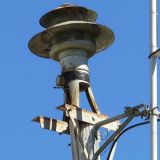
The Champion Giant (Type 2A2¾) is a vertical single-headed electric fire siren, and the smallest of the 3-legged vertical Champions. It borrows a singular 13½" rotor and stator from the Peerless Champion and is driven by a single-sided 2½ hp 220 V AC motor below the rotor and stator assembly. 1 ph, 3 ph, and universal motor configurations were offered. The intake on the Champion Giant is protected by a large 2-piece intake cover attached to the stator, which keeps debris and rain out of the rotor. The siren is equipped with a mesh screen around the intake and stator ports; as these were prone to damage, detaching, or simply degrading with age, many Champion Giants can be seen with modifications to further protect the siren's intake and stator. 3 curved mounting legs below the motor suspend the siren and have lugs at the bases which allow the siren to be bolted to a flat surface.
Champion Giants are easily distinguishable from the larger 2 3-legged vertical Champions by the notably shorter stator and legs that have a longer, less prominently curved form. Champion Giants are exclusively 8-port single tone, and have intake covers that extend halfway down the stator. The model name of the siren and many other Darley offerings is based off a factory code; what exactly the names correlate to is unknown, sans the "U", "S" and "T" suffixes which denote the type of motor used and correspond to universal, 1 ph, and 3 ph respectively. These were some of the cheapest sirens available in the 1930s (advertised as "The Buy of 1932" in a 1932 advertisement), which made them quite popular at the time despite the larger Champion Fire Siren(s) offering superior performance. Champion Giants, while not exactly widespread, are still relatively common and have even found their way as far north as Quebec, Canada.
Champion Fire Siren
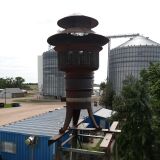
The Champion Fire Siren name does not refer to a singular model, but rather 2 vertical single-headed electric fire sirens which went under the same name and are visually identical. These were larger than the Champion Giant and were pushed far more than the Giant in Darley advertisements, although their hefty price tag ironically made the Champion Fire Siren(s) less of a popular choice. The Fire Siren(s) borrow(s) a singular 13½" rotor and stator from the Super Champion and is/are driven by a single-sided 220 V AC motor below the rotor and stator assembly. 1 ph, 3 ph, and universal motor configurations were offered. The difference between the 2 Fire Siren models is the horsepower; 5 hp (Type 2C2½) and 7½ hp (Type 2C3½) were offered; there are no other differences between the Champion Fire Sirens besides this. Differentiating them is impossible without a view of the manufacturing tag on the motor.
The intake on the Champion Fire Siren(s) is/are protected by an either single or 2-peice intake cover attached to the stator, which keeps debris and rain out of the rotor. The cover is topped with a small eagle decoration, although this decoration has never been seen on any existing Champion Fire Siren installations and was either rarely included or never produced at all. The siren(s) is/are equipped with a mesh screen around the intake and stator ports; as these were prone to damage, detaching, or simply degrading with age, many Champion Fire Sirens can be seen with modifications to further protect the siren's intake and stator. 3 curved mounting legs below the motor suspend the siren(s) and have lugs at the bases which allow the siren(s) to be bolted to a flat surface. Champion Fire Sirens are distinguishable from the smaller Champion Giant by the taller stator and shorter legs that have a longer, less prominently curved form.
These sirens could come in both 8 or 12-port single tone, and have intake covers that extend to the very top of the stator. As the Super Champion, of which the Champion Fire Siren(s) is/are derived from, were offered in a 16-port single tone configuration, it is possible that 16-port Champion Fire Sirens could have been requested, although none of these, if they existed to begin with, have surfaced. The model name of the siren and many other Darley offerings is based off a factory code; what exactly the names correlate to is unknown, sans the "U", "S" and "T" suffixes which denote the type of motor used and correspond to universal, 1 ph, and 3 ph respectively. Champion Fire Sirens themselves were not as popular as their smaller counterpart, and as a result Champion Fire Sirens are harder to come by. Even less of which are operational to begin with; most Champion Fire Sirens that are see service either as fire sirens or noon whistles.
Weatherproof Champion
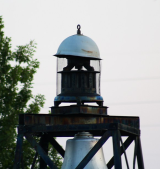
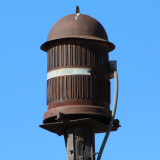
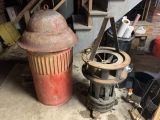
The Weatherproof Champions are vertical single-headed electric fire sirens, and were designed with durability and longevity in mind, rather than price and raw performance. Unlike the vertical 3-legged Champions, the Weatherproof Champions use a motor-over-rotor configuration, with the motor on top and the rotor and stator below it. A cylindrical base. Under the stator a circular base with lugs allows the siren to be bolted to a flat surface. These sirens are placed inside weatherproof housings with a rounded top, and many slits are placed across the diameter of the housing to allow sound to escape, similar to a Sparton Model 37/38. While this does a much better job of protecting the siren itself from the elements, it does harm the siren's ability to project, and they tend to be quieter than other Champion models.
The Weatherproof Champion was offered in 3 different varieties; the smallest of the 3, a 2½ hp variant, is similar to the Federal Signal Model 2, and comes exclusively in 6-port single tone. It uses a universal motor, with shorter overall shorter housings than the other Weatherproof Champions. The mid-range 5 hp variant, which uses a standard 5 hp AC motor, comes with an either 8-port or 12-port rotor with 6 long vanes and 6 short vanes, giving it a significant rasp, similar to Sterling's 5VX sirens, of which these sirens were competitors of. 5 hp models are taller than the 2½ hp model and have 2 rows of slits. Finally, the 7½ hp variant, which is similar to the 5 hp model, comes exclusively in 12-port single tone, with a rotor that has all long vanes and no short vanes.
Weatherproof Champions produced from the 1940s onwards were simply Fedelcode sirens with Darley's weatherproof housings, instead of Darley's own designs. These can be told apart from earlier Darley-designed models by the style of the louvres, as the louvres are bi-directional on Darley models, while the louvres are open on only 1 side on Federal rebranded Champions. Federal rebranded Champions also only have 1 row of ports, and a 2-piece cover. Darley models only have a single-piece cover, and 2 rows of slits. Sirens that received weatherproof housings included the C2 1/2, Model 1, and Model 2. These would be the standard Weatherproof Champion design until their discontinuation. The Weatherproof Champions were one of the most popular of Darley's sirens despite other models offering superior performance. Even today these sirens are very recognizable and are synonymous with the Darley name. Weatherproof Champions can be found across the United States largely serving as either fire sirens, weather sirens, or noon whistles.